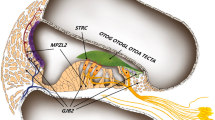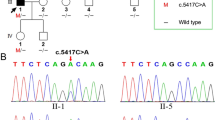Abstract
Objective
Hearing loss (HL) is the most common sensory organ dysfunction disease. The cause is often complex, though genetics are the main factor.
Methods
In this study, we investigated a Chinese family with non-syndromic delayed post-lingual deafness. Comprehensive data collection was performed on this family’s members, including basic information, audiological examinations, blood system examinations and imaging examinations. A pedigree diagram was drawn and the genetic patterns were analyzed.
Results
A new gene mutation, c.314A>T:p.Y105F in the MYH9 exon, was confirmed by next generation sequencing and Sanger sequencing. This mutation co-segregated with the phenotype in the pedigree. Patients in this family present bilateral symmetry and gradual and delayed high-frequency sensorineural hearing loss. The age of onset was approximately 30 years old. Except for hearing loss, no lesions were seen in other organs, especially the blood system.
Conclusion
The identification and detection of a novel MYH9 mutation may be of great significance to provide the basis for gene function research and genetic consultation.






Similar content being viewed by others
References
Dror AA, Avraham KB (2009) Hearing loss: mechanisms revealed by genetics and cell biology. Annu Rev Genet 43:411–437
Alford RL, Arnos KS, Fox M, Lin JW, Palmer CG, Pandya A et al (2014) American College of Medical Genetics and Genomics guideline for the clinical evaluation and etiologic diagnosis of hearing loss. Genet Med 16:347–355
Chang KW (2015) Genetics of hearing loss-nonsyndromic. Otolaryngol Clin North Am 48:1063–1072
Lenz DR, Avraham KB (2011) Hereditary hearing loss: from human mutation to mechanism. Hear Res 281:3–10
Pecci A, Ma X, Savoia A, Adelstein RS (2018) MYH9: structure, functions and role of non-muscle myosin IIA in human disease. Gene 20:152–167
Liu Y, Li R, Chen XX, Zhi Y, Deng R, Zhou EM et al (2019) Nonmuscle myosin heavy chain IIA recognizes sialic acids on sialylated RNA viruses to suppress proinflammatory responses via the DAP12-Syk pathway. mBio 10:e00574-19
Sloan-Heggen CM, Bierer AO, Shearer AE, Kolbe DL, Nishimura CJ, Frees KL et al (2016) Comprehensive genetic testing in the clinical evaluation of 1119 patients with hearing loss. Hum Genet 135:441–450
Wu CC, Lin YH, Lu YC, Chen PJ, Yang WS, Hsu CJ et al (2013) Application of massively parallel sequencing to genetic diagnosis in multiplex families with idiopathic sensorineural hearing impairment. Plos One 8:e57369
Lalwani AK, Goldstein JA, Kelley MJ, Luxford W, Castelein CM, Mhatre AN (2000) Human nonsyndromic hereditary deafness DFNA17 is due to a mutation in nonmuscle myosin MYH9. Am J Hum Genet 67:1121–1128
Mhatre AN, Li J, Kim Y, Coling DE, Lalwani AK (2004) Cloning and developmental expression of nonmuscle myosin II A(MYH9) in the mammalian inner ear. J Neurosci Res 76:296–305
Mhatre AN, Li Y, Atkin G, Maghnouj A, Lalwani AK (2006) Expression of MYH9 in the mammalian cochlea: localization within the stereocilia. J Neurosci Res 84:809–818
Lalwani AK, Luxford WM, Mhatre AN, Attaie A, Wilcox ER, Castelein CM (1999) A new locus for nonsyndromic hereditary hearing impairment, DFNA17, maps to chromosome 22 and represents a gene for cochleosaccular degeneration. Am J Hum Genet 64:318–323
Pecci A, Klersy C, Gresele P, Lee KJ, De Rocco D, Bozzi V et al (2014) MYH9-related disease: a novel prognostic model to predict the clinical evolution of the disease based on genotype-phenotype correlations. Hum Mutat 35:236–247
Hildebrand MS, de Silva MG, Gardner RJ, Rose E, de Graaf CA, Bahlo M et al (2006) Cochlear implants for DFNA17 deafness. Laryngoscope 116:2211–2215
Saposnik B, Binard S, Fenneteau O, Nurden A, Nurden P, Hurtaud-Roux MF et al (2014) Mutation spectrum and genotype-phenotype correlations in a large French cohort of MYH9-related disorders. Mol Genet Genomic Med 2:297–312
Verver E, Pecci A, De Rocco D, Ryhänen S, Barozzi S, Kunst H et al (2014) R705H mutation of MYH9 is associated with MYH9-related disease and not only with non-syndromic deafness DFNA17. Clin Genet 88:85–89
Kunishima S, Matsushita T, Kojima T, Amemiya N, Choi YM, Hosaka N et al (2001) Identification of six novel MYH9 mutations and genotype-phenotype relationships in autosomal dominant macrothrombocytopenia with leukocyte inclusions. J Hum Genet 46:722–729
Acknowledgements
This work was supported by grants from the Jiangsu Provincial Commission of Health and Family Planning (No. H2017061), the Science and Technology Bureau of Suzhou (No. SS201861) and the Science and Technology Bureau of Suzhou (No. SLT202007).
Author information
Authors and Affiliations
Corresponding author
Ethics declarations
Conflict of interest
The authors disclose no conflicts of interest.
Additional information
Publisher's Note
Springer Nature remains neutral with regard to jurisdictional claims in published maps and institutional affiliations.
Rights and permissions
About this article
Cite this article
Pan, C., Zhang, Y., Yang, S. et al. A novel MYH9 mutation related to non-syndromic delayed post-lingual sensorineural hearing loss. Eur Arch Otorhinolaryngol 279, 2811–2817 (2022). https://doi.org/10.1007/s00405-021-06976-2
Received:
Accepted:
Published:
Issue Date:
DOI: https://doi.org/10.1007/s00405-021-06976-2




